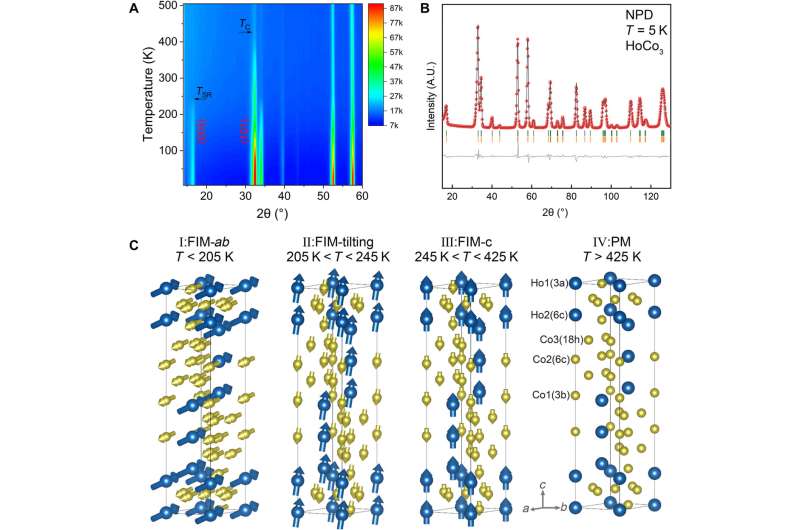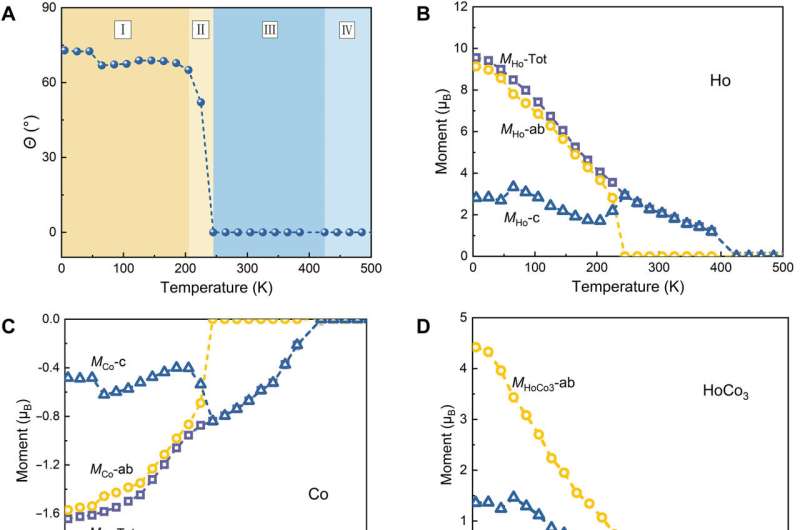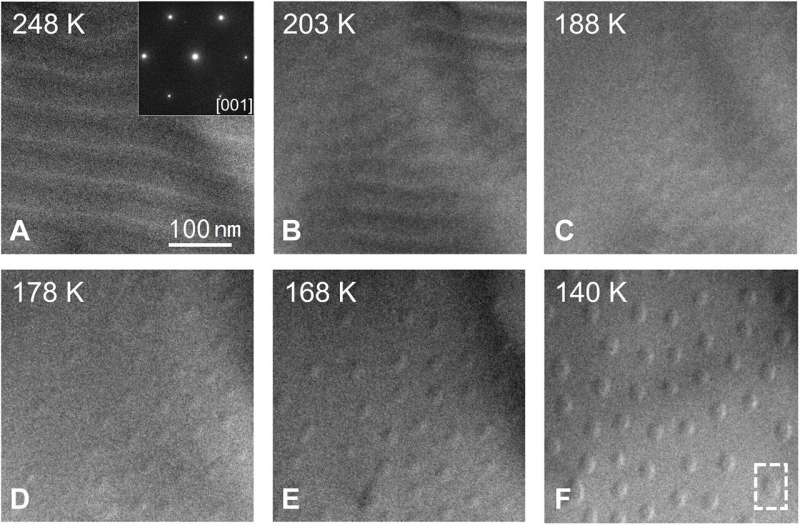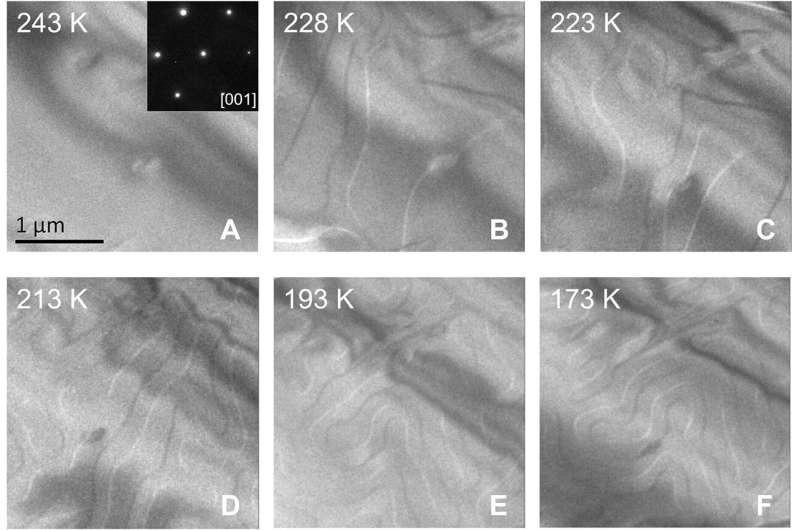September 16, 2023 feature
This article has been reviewed according to Science X's editorial process and policies. Editors have highlighted the following attributes while ensuring the content's credibility:
fact-checked
peer-reviewed publication
trusted source
proofread
Generating biskyrmions in a rare earth magnet

Magnetic skyrmions have received much attention as promising, topologically protected quasiparticles with applications in spintronics. Skyrmions are small, swirling topological magnetic excitations with particle-like properties. Nevertheless, the lower stability of magnetic skyrmions only allow them to exist in a narrow temperature range, with low density of the particles, thus implying the need for an external magnetic field, which greatly limits their wider applications.
In a new report published in Science Advances, Yuzhu Song and a team of researchers formed high-density, spontaneous magnetic biskyrmions without a magnetic field in ferrimagnets via the thermal expansion of the lattice.
The team noted a strong connection between the atomic-scale ferrimagnetic structure and nanoscale magnetic domains in a ferrimagnet compound by using neutron powder diffraction and Lorentz transmission electron microscopy measurements.
Song and team explored the critical role of negative thermal expansion in generating biskyrmions in the ferrimagnet compound due to magneto-elastic coupling effects, to compare the behavior of the material with positive thermal expansion.
Skyrmions and biskyrmions
Magnetic skyrmions are nanoscale magnetic domain structures with topological protection. Their unique features and small size, and the lower energy consumption alongside electric-current driven behavior make them promising candidates for applications in spintronic storage devices.
Since their discovery in 2009, magnetic skyrmions have entered a period of rapid development. Materials scientists and physicists have found topological spin structures to contain diverse topological charges, which include skyrmions, biskyrmions, anti-skyrmions, merons and antimerons. The competition between magnetic dipole interactions and uniaxial magnetic anisotropy usually determines the generation of biskyrmions.

In this work, the research team proposed the stabilization of high-density, spontaneous magnetic biskyrmions across a wide-range of temperatures by investigating the negative thermal expansion of a lattice, when compared to a bulk metallic ferrimagnetic compound composed of a holmium-cobalt system [Ho(Co,Fe)3].
The team comparatively studied the compound by characterizing positive thermal expansion and the mechanism of negative thermal expansion, to understand the stability of magnetic biskyrmions within the rare earth magnet (HoCo3).
The experiments
The research team first obtained crystal and magnetic structures of the magnetic compound by performing variable-temperature dependent neutron-powder diffraction measurements. They noted a distinct variation of the material's profile intensity across diverse temperature ranges and showed the expression of complex magnetic structural changes.
Song and team determined the crystal structure of the material and explored the magnetic moments of the rare earth element holmium (Ho) constituting the compound, alongside the transition metal atom cobalt (Co).
The magnetic moment of the ferrimagnet rotated with varying temperatures to create a phenomenon known as spin reorientation, allowing them to measure the temperature-dependence of the magnetization process. When temperatures exceeded ~425 K, the magnetic structure assumed a disordered paramagnetic state. The outcomes of the magnetic structure fit the neutron powder diffraction data well at all temperatures.

The magnetic moment
The scientists summed up the temperature-dependent evolution of the magnetic and structural parameters of the ferrimagnet across an entire temperature range. They noted the expansion of a unit cell of a magnetic compound with increased temperature due to anharmonic lattice vibrations. They also conducted additional neutron powder diffraction studies to calculate the magnetic components and total magnetic moments of the constituting holmium and cobalt atoms.
The team explored the complex magnetic ordering in the ferrimagnetic holmium-cobalt system by calculating the band structures and density states of the compound via first principles. As with many rare-earth systems, the Ruderman–Kittel–Kasuya–Yosida (RKKY) interactions underlay the complex magnetism of the ferrimagnet.

Comparing lattice negative thermal expansion and positive thermal expansion
During additional experiments, Song and team conducted neutron powder diffraction analysis to show the rotating magnetic moment of the holmium-cobalt system with lattice negative thermal expansion at cooling.
Under zero magnetic field, the scientists imaged the magnetic domain structures of the ferrimagnet across a temperature range, to show varying magnetic biskyrmions of the compound. They regarded the spin texture of biskyrmions as being composed of two skyrmions with opposite helices.
The spontaneous skyrmions represented very high densities with stability across a wide temperature range. They compared the lattice negative thermal expansion of the holmium-cobalt system and the existence of stable skyrmions by characterizing the outcomes with another compound containing iron to show positive thermal expansion in the latter.
The team did not observe any skyrmions in this latter ferrous-integrated compound, which they investigated at the same temperature range during which biskyrmions appeared in the holmium-cobalt system.
Outlook
In this way, Yuzhu Song and team explored the consistency of lattice expansion and the gradual increase of biskyrmions due to decreasing temperatures, by confirming negative thermal expansion during the stabilization of biskyrmions within a rare earth magnet.
The team obtained high-density, spontaneous magnetic biskyrmions across a wide temperature range, without applying a magnetic field to the bulk holmium-cobalt systems. They determined the complex magnetic and crystal structures of the compounds using neutron powder scattering across the entire experimental temperature range.
The outcomes highlighted an expanded mechanism to generate spontaneous, high-density skyrmions across a broad temperature range in rare earth metal systems.
More information: Yuzhu Song et al, High-density, spontaneous magnetic biskyrmions induced by negative thermal expansion in ferrimagnets, Science Advances (2023). DOI: 10.1126/sciadv.adi1984
X. Z. Yu et al, Real-space observation of a two-dimensional skyrmion crystal, Nature (2010). DOI: 10.1038/nature09124
Journal information: Science Advances , Nature
© 2023 Science X Network





















